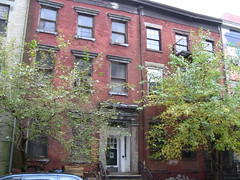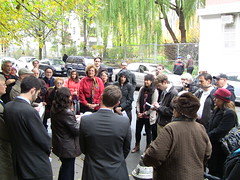 Spencer Magloff Preservationists had sought landmark designations for these two buildings at 326 and 328 East Fourth Street.
Spencer Magloff Preservationists had sought landmark designations for these two buildings at 326 and 328 East Fourth Street.On the same day that two preservation groups held a news conference urging the Landmarks Preservation Commission to reconsider refusing to designate a pair of 170-year old buildings at 326 and 328 East Fourth Street as historic landmarks, the Department of Buildings awarded permits for both buildings to developer Terrence Lowenberg.
“This is truly outrageous,” said Andrew Berman, executive director of the Greenwich Village Society for Historic Preservation, who learned from The Local that the permits had been issued.
“It’s tragic that the Landmarks Preservation Commission sat on their hands for more than three months and allowed this to happen,” said Mr. Berman, whose group led the landmark designation effort. “A wonderful piece of the city’s history will likely be destroyed due to the city’s inaction.”
The permits, which were filed by Ramy Issac of Issac and Stern Architects in August, were approved Tuesday, according to Ryan Fitzgibbon, a spokeswoman for the Department of Buildings. The estimated total costs in renovations is $568,900 for each building, and include adding two floors to the current three-story structures, altering the number of dwelling units and its occupancy or use.
Neither Mr. Lowenberg nor Mr. Issac responded to messages by phone or e-mail seeking comment.
Built before the Civil War, the Greek Revivalist row houses are among the oldest buildings in the East Village. Today their stoops and areaways, cornices and architectural details have remained surprisingly intact, and their long and storied histories serve as a vestige of a bygone era, a memento of an older time. Inside the row houses are in desperate need of repair. Wild cats roam their abandoned corridors, rustic walls are punctured with holes, appliances are smeared with rust, and water leaks from a roof held up with little more than black plastic sheeting.
 Spencer Magloff Advocates held a rally Tuesday calling for the preservation of the buildings. On the same day, permits were issued that would allow developers to alter the structures.
Spencer Magloff Advocates held a rally Tuesday calling for the preservation of the buildings. On the same day, permits were issued that would allow developers to alter the structures.The buildings have a checkered history. They were originally built for shipping merchants who were based near what was then the East River docks. Following a great wave of Jewish immigration at turn of the 19th century, one of the buildings then became a Hasidic Synagogue home to Congregation Hesed LeAvraham for nearly 50 years until 1970.
“When 2.5 million Jews emigrated here from Europe, 500,000 settled here,” said Laurie Tobias Cohen, executive director of the Lower East Side Jewish Conservatory.
Today, the deserted houses are littered with temple ornaments, bohemian art, and handmade instruments, all remnants of the buildings most recent tenants, the Uranian Phalanstery. The group, which describes itself as an “anarchist utopian commune for practitioners of art and cosmology,” sold off the two properties when faced with tax liens, and moved its headquarters to Hamilton Heights in Upper Manhattan.
Mr. Berman’s group and East Village Community Coalition have been at the forefront of a back-and-forth battle to save the buildings since August, when the two preservation groups applied for landmark status. However, their request was denied.
“After carefully reviewing the proposals we found that both buildings have suffered the loss and replacement of some significant features, and are in too poor a physical condition to rise to the level of individual landmarks,” the chairman of the landmarks commission, Robert B. Tierney, said in August.



